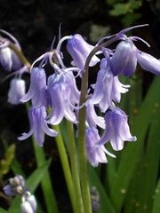
Spanish Bluebell
Encyclopedia
The Spanish Bluebell is a spring-flowering bulbous perennial native to the Iberian Peninsula
. It is one of around 11 species
in the genus
Hyacinthoides
, others including the Common Bluebell
(Hyacinthoides non-scripta) in northwestern Europe
, and the Italian Bluebell
(Hyacinthoides italica) further east in the Mediterranean region.
It is distinguished from the Common Bluebell by its paler, larger blue flowers, more erect flower stem (raceme
), broader leaves, blue anthers (where the Common Bluebell has creamy-white ones) and little or no scent compared to the strong fragrant scent of the northern species.
The Spanish Bluebell was introduced in the United Kingdom
, where it has become an invasive species
. The two species hybridise freely, and the resulting hybrid Hyacinthoides × massartiana and the Spanish Bluebell both produce highly fertile seed
and can invade areas of the native Common Bluebell. This has caused the Common Bluebell to be viewed as a threatened species
.
The Spanish Bluebell is also cultivated as a garden plant, and several named cultivar
s exist with flowers in various shades of white, pink and blue.
Iberian Peninsula
The Iberian Peninsula , sometimes called Iberia, is located in the extreme southwest of Europe and includes the modern-day sovereign states of Spain, Portugal and Andorra, as well as the British Overseas Territory of Gibraltar...
. It is one of around 11 species
Species
In biology, a species is one of the basic units of biological classification and a taxonomic rank. A species is often defined as a group of organisms capable of interbreeding and producing fertile offspring. While in many cases this definition is adequate, more precise or differing measures are...
in the genus
Genus
In biology, a genus is a low-level taxonomic rank used in the biological classification of living and fossil organisms, which is an example of definition by genus and differentia...
Hyacinthoides
Hyacinthoides
Hyacinthoides is a genus of the family Asparagaceae, subfamily Scilloideae. It has also been placed in the separate family Hyacinthaceae and before that the Liliaceae. The genus is included within Scilla by some botanists....
, others including the Common Bluebell
Common Bluebell
Hyacinthoides non-scripta, commonly known as the common bluebell, is a spring-flowering bulbous perennial plant. -Taxonomy:...
(Hyacinthoides non-scripta) in northwestern Europe
Europe
Europe is, by convention, one of the world's seven continents. Comprising the westernmost peninsula of Eurasia, Europe is generally 'divided' from Asia to its east by the watershed divides of the Ural and Caucasus Mountains, the Ural River, the Caspian and Black Seas, and the waterways connecting...
, and the Italian Bluebell
Italian Bluebell
The Italian Bluebell or Italian Squill , is a spring-flowering bulbous perennial native to the central Mediterranean region in northwestern Italy, southern France and northeastern Spain...
(Hyacinthoides italica) further east in the Mediterranean region.
It is distinguished from the Common Bluebell by its paler, larger blue flowers, more erect flower stem (raceme
Raceme
A raceme is a type of inflorescence that is unbranched and indeterminate and bears pedicellate flowers — flowers having short floral stalks called pedicels — along the axis. In botany, axis means a shoot, in this case one bearing the flowers. In a raceme, the oldest flowers are borne...
), broader leaves, blue anthers (where the Common Bluebell has creamy-white ones) and little or no scent compared to the strong fragrant scent of the northern species.
The Spanish Bluebell was introduced in the United Kingdom
United Kingdom
The United Kingdom of Great Britain and Northern IrelandIn the United Kingdom and Dependencies, other languages have been officially recognised as legitimate autochthonous languages under the European Charter for Regional or Minority Languages...
, where it has become an invasive species
Invasive species
"Invasive species", or invasive exotics, is a nomenclature term and categorization phrase used for flora and fauna, and for specific restoration-preservation processes in native habitats, with several definitions....
. The two species hybridise freely, and the resulting hybrid Hyacinthoides × massartiana and the Spanish Bluebell both produce highly fertile seed
Seed
A seed is a small embryonic plant enclosed in a covering called the seed coat, usually with some stored food. It is the product of the ripened ovule of gymnosperm and angiosperm plants which occurs after fertilization and some growth within the mother plant...
and can invade areas of the native Common Bluebell. This has caused the Common Bluebell to be viewed as a threatened species
Threatened species
Threatened species are any speciesg animals, plants, fungi, etc.) which are vulnerable to endangerment in the near future.The World Conservation Union is the foremost authority on threatened species, and treats threatened species not as a single category, but as a group of three categories,...
.
The Spanish Bluebell is also cultivated as a garden plant, and several named cultivar
Cultivar
A cultivar'Cultivar has two meanings as explained under Formal definition. When used in reference to a taxon, the word does not apply to an individual plant but to all those plants sharing the unique characteristics that define the cultivar. is a plant or group of plants selected for desirable...
s exist with flowers in various shades of white, pink and blue.

